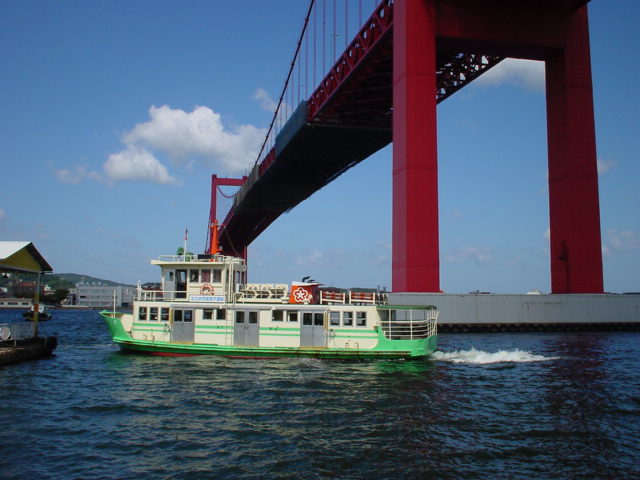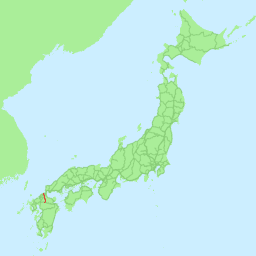|
Transport In Fukuoka-Kitakyūshū
Transport in Fukuoka-Kitakyushu is similar to that of other large cities in Japan, but with a high degree of private transport. The region is a hub of international ferry services and has a high degree of air connectivity and a considerable rail transport network, complemented with highways and surface streets. It includes public and private rail and highway networks; airports for international, domestic, and general aviation; buses; motorcycle delivery services, walking, bicycling, and commercial shipping. The foci of the public transport system are Hakata Station, Tenjin Station, and Kokura Station, in Fukuoka and Kitakyushu cities respectively. Between these two cities lies a more sparse weblike regional rail network. The transit network consists of 32 surface and subterranean railway lines (see section on rail transport) operated by several and private operators. Monorails, trams, fixed-guideway lines and buses support this primary rail network. Like other cities in Japan, ... [...More Info...] [...Related Items...] OR: [Wikipedia] [Google] [Baidu] |
Kagoshima
, abbreviated to , is the capital city of Kagoshima Prefecture, Japan. Located at the southwestern tip of the island of Kyushu, Kagoshima is the largest city in the prefecture by some margin. It has been nicknamed the "Naples of the Eastern world" for its bay location (Aira Caldera), hot climate, and emblematic stratovolcano, Sakurajima. The city was officially founded on April 1, 1889. It merged with Taniyama City on April 29, 1967 and with Yoshida Town, Sakurajima Town, Kiire Town, Matsumoto Town and Kōriyama Town on November 1, 2004. Etymology The name "Kagoshima" (鹿児島) literally means "deer child island" or "young-deer island". In the Kagoshima dialect, local names for the city include “かごっま (Kagomma)”, “かごんま (Kagonma)”, “かごいま (Kagoima)” and “かごひま (Kagohima)”. While the kanji for Kagoshima ( 鹿 児 島) literally mean "deer child island", or "island of the fawn" for certain, the source etymology is not clear and ma ... [...More Info...] [...Related Items...] OR: [Wikipedia] [Google] [Baidu] |
Hakata Minami Line
The is an long railway line in Fukuoka Prefecture, Japan, connecting Hakata Station in Fukuoka with Hakata-Minami Station in Kasuga. It is operated by the West Japan Railway Company (JR West). Service Although the line uses Shinkansen equipment, trains are officially designated as limited express trains. In practice, however, most services are extensions of San'yō Shinkansen '' Kodama'' services. The Kyushu Shinkansen, opened on 12 March 2011, shares part of the route. The trip from Hakata to Hakata-Minami takes ten minutes and costs ¥300. File:Tickets for Hakata-Minami Station sold at Hakata Station.jpg, 100 yen limited express supplementary ticket for travel from Hakata to Hakata Minami Rolling stock * 500-7000 series 8-car sets * 700-7000 series 8-car ''Rail Star'' sets * N700-7000/ 8000 series 8-car sets History The line was originally opened in March 1975 to transport San'yō Shinkansen trains from the Hakata terminal to Hakata Depot in Kasuga. At that time, Ka ... [...More Info...] [...Related Items...] OR: [Wikipedia] [Google] [Baidu] |
Chikuhi Line
The is a railway line in Kyushu, Japan, connecting Meinohama Station in Fukuoka, Fukuoka (and via a subway through service, Fukuoka itself) to Karatsu Station in Karatsu, Saga, and from Yamamoto Station in Karatsu to Imari Station in Imari, Saga. Trains from Karatsu to Imari use the Karatsu Line to Yamamoto. Route data *Operators and distances **JR Kyushu ***From Meinohama to Karatsu: ***From Yamamoto to Imari: *Track gauge: *Stations: 29 *Double-track: From Meinohama to Chikuzen-Maebaru *Electrified track: Meinohama to Nishi-Karatsu only; Yamamoto to Imari is unelectrified Station list Eastern section :●: Stops, |: Does not stop :Rapid Service: Stops at every station on the Kūkō Line Western section All trains running on this section stop at all stations. Rolling stock * 103-1500 series six-car EMUs (since 1982) * 303 series six-car EMUs (since 22 January 2000) * 305 series six-car EMUs (since February 2015) A fleet of six new 305 series six-car electric ... [...More Info...] [...Related Items...] OR: [Wikipedia] [Google] [Baidu] |
Kashii Line
The is a railway line in Japan operated by Kyushu Railway Company (JR Kyushu). It connects Saitozaki Station in Fukuoka with Umi Station in Umi. Stations History The Hakata Bay Railway Co. opened the Saitozaki - Sue section in 1904, extending it to the Otani coal mine (1 km beyond Umi) the following year. In 1942, the company merged with the Nishi-Nippon Railroad company, which was nationalised in 1944. The line beyond Umi closed in 1980. Former connecting lines Sakado station - The 14 km Katsuta line was opened by the Chikuzen Sangu Railway Co. from Yusu (on the Sasaguri Line is a railway line in Japan operated by Kyushu Railway Company (JR Kyushu). It connects Keisen Station in Keisen, Fukuoka with Yoshizuka Station in Fukuoka, Fukuoka. Stations History The Kyushu Railway Co. opened the Yoshizuka - Sasaguri ...) - Chikuzenkatsuta in 1918-19. The connection to Sakado opened in 1942, and the line was nationalised in 1944. Freight service ceased in 1981 ... [...More Info...] [...Related Items...] OR: [Wikipedia] [Google] [Baidu] |
Hitahikosan Line
The is a railway line in Japan, operated by Kyushu Railway Company (JR Kyushu). It connects Jōno Station in Kitakyushu, Fukuoka Prefecture with Yoake Station in Hita, Ōita Prefecture and features the 4380 m Shakadake Tunnel between Chikuzen Iwaya and Hikosan station, where a fatal tunnel collapse occurred during construction in 1953, killing 21 construction workers. The line is named after Hita and Mount Hiko. Stations :●: Stops, |: non-stop History The Toyo-shu Railway Co. opened the Tagawa-Ita - Buzen Kawasaki section as part of the Tagawa Line in 1899. That company merged with the Kyushu Railway Company in 1901, which extended the line to Soeda in 1903. The company was nationalised in 1907. The Jono - Tagawa-Ita section was opened in 1915 by the Kokura Railway Co., that company being nationalised in 1943. The Soeda - Daigyoji section opened between 1937 and 1946, and the Daigyoji - Yoake section opened in 1956. CTC signalling was introduced on the entire line in 1 ... [...More Info...] [...Related Items...] OR: [Wikipedia] [Google] [Baidu] |
Nippo Main Line
Nippo may refer to: Companies and organizations * Nippo, colloquial name for * Nippo Batteries, an Indian battery manufacturer * Nippo Corporation, a Japanese construction company and sponsor of cycling teams ** EF Education–Nippo, a cycling team that competed during 2021 ** Nippo–Provence–PTS Conti, a cycling team formed in November 2020 ** Nippo–Vini Fantini–Faizanè, a cycling team that competed from 2008 to 2019 Places * Nippō Kaigan Quasi-National Park, in Japan * Nippo Pond, a body of water in Barrington, New Hampshire Other * Nippo, a Japanese male villain in the Shazam family of comic book characters during the 1940s and 1950s * ''Nippo Jisho The or ''Vocabulario da Lingoa de Iapam'' (''Vocabulário da Língua do Japão'' in modern Portuguese; "Vocabulary of the Language of Japan" in English) is a Japanese to Portuguese dictionary compiled by Jesuit missionaries and published in ...'', a Japanese to Portuguese dictionary of the 17th century * Nippō ... [...More Info...] [...Related Items...] OR: [Wikipedia] [Google] [Baidu] |
Kagoshima Main Line
The is a major railway line operated by the Kyushu Railway Company (JR Kyushu) between Mojikō in Kitakyushu, and Kagoshima Station in Kagoshima City, at the southern end of Kyushu. Until March 13, 2004, it extended 393 km between its two termini; however, with the opening of the Kyushu Shinkansen on March 13, the section between Yatsushiro and Sendai was transferred to the third-sector Hisatsu Orange Railway Company. The line is an important line in Kyushu, connecting Fukuoka (Hakata Station) to many other major cities. It is the main line through the Fukuoka urban district, and as such many long-distance express trains from all parts of Kyushu use the section between Kokura Station (Kitakyushu) and Tosu Station, where the Nagasaki Main Line meets the Kagoshima Main Line. Stations Mojikō – Arao Arao – Yatsushiro Sendai – Kagoshima Footnotes Former Yatsushiro – Sendai section This section was transferred to the Hisatsu Orange Railway Line ... [...More Info...] [...Related Items...] OR: [Wikipedia] [Google] [Baidu] |
Gotōji Line
The is a Japanese railway line in Fukuoka Prefecture connecting Tagawa-Gotōji Station in the city of Tagawa and Shin-Iizuka Station in the city of Iizuka. It is part of the JR Kyushu network. Basic data *Operator, distances: **Kyushu Railway Company (JR Kyushu) (Services and tracks) ***Tagawa-Gotōji – Shin-Iizuka: *Gauge: Narrow gauge, *Stations: 6 *Double-tracking: None *Electrification: None *Railway signalling: Special automatic Station list * All stations are located in Fukuoka Prefecture. * Rapid trains, which only operate in the direction of Tagawa-Gotōji, stop at stations marked "●" and pass stations marked "↑". History The Hōshū Railway Co. opened the central section of the line in 1897 to haul freight, the company merging with the Kyushu Railway was a company that built and operated railways in Kyushu, one of four main islands of Japan. Most of its lines came under the control of Japanese Government Railways following nationalization in 1907, a ... [...More Info...] [...Related Items...] OR: [Wikipedia] [Google] [Baidu] |
Sasaguri Line
is a railway line in Japan operated by Kyushu Railway Company (JR Kyushu). It connects Keisen Station in Keisen, Fukuoka with Yoshizuka Station in Fukuoka, Fukuoka. Stations History The Kyushu Railway Co. opened the Yoshizuka - Sasaguri section in 1904, and extended it to Hakata with a line paralleling the Kagoshima Main Line the following year. The company was nationalised in 1907. In 1911 the Kagoshima Main line was duplicated utilising the parallel line, and the junction between the lines became Yoshizuka. Petrol railcars were introduced on the line in 1936. In 1968 the line was extended from Sasaguri to Katsura (on the Chikuho Main Line), with freight services commencing on that section in 1970. Freight service on the entire line ceased in 1984. The line was electrified in 2001. Former connecting lines Yusu Station: The 14 km Katsuta Line was opened by the Chikuzen Sangu Railway Co. to Chikuzenkatsuta between 1918 and 1919. A connection to Sakado on the Kashii Line ... [...More Info...] [...Related Items...] OR: [Wikipedia] [Google] [Baidu] |
Fukuhoku Yutaka Line
The is the collective name for four sections of railway lines operated by Kyushu Railway Company (JR Kyushu) in Fukuoka Prefecture, Japan. It runs between Kurosaki Station and Hakata station (66.6 km). The sections called Fukuhoku Yutaka Line are: * Part of the Kagoshima Main Line, between Kurosaki Station and Orio Station - 5.2 km * Part of the Chikuhō Main Line, between Orio Station and Keisen Station - 34.5 km * The entire Sasaguri Line, between Keisen Station and Yoshizuka Station - 25.1 km * Part of the Kagoshima Main Line, between Yoshizuka Station and Hakata Station - 1.8 km Rolling stock A pre-series two-car BEC819 series AC battery electric multiple unit A battery electric multiple unit (BEMU), battery electric railcar or accumulator railcar is an electrically driven multiple unit or railcar whose energy is derived from rechargeable batteries driving the traction motors. Prime advantages of these ... (BEMU) was tested on the line from Ap ... [...More Info...] [...Related Items...] OR: [Wikipedia] [Google] [Baidu] |





